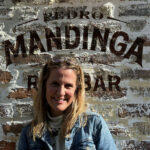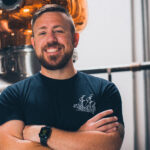A Sip of Knowledge with Brad Kraus of Pedro Mandinga Rum
On July 27, 2021 started a livestream of the program “A Sip Of Knowledge” was held at ZAVVY, hosted by Liz Rhoades, a technical distiller and spirits consultant with over a decade of experience in the spirits industry, Lew Bryson, a long-time whisky writer and he was the managing editor of Whisky Advocate magazine for 20 years, and Martin Duffy DIAGEO’s whisky Master for the Midwest, ho will talk to us about whiskey, spirits, distilling, marketing and the current state of the beverage industry. With the company of Brad Kraus master distiller at Pedro Mandinga Rum.
The Journey of Brad Kraus
Brad Krus, the Master Distiller at Pedro Mandinga Rum, has a fascinating journey that spans across continents and industries. Born and raised in New Mexico, Brad moved to Texas for his high school education. His passion for chemistry led him to pursue a degree in the subject at Rice University. His education at Rice was made possible through an ROTC scholarship, which subsequently required him to serve in the military.
Upon completing his military service, Brad returned to Texas where he began home brewing. His interest in brewing was so intense that one of his mentors, Dr. George Fix, encouraged him to pursue it professionally. Heeding this advice, Brad moved back to New Mexico in the late 80s, just as the first wave of craft brewing was taking off in the United States.
In addition to his brewing experience, Brad also studied enology and viticulture at Grayson County College in Texas. Despite his love for wine, he initially found work as a brewer. He was thrilled to be back in his home state, doing what he loved and felt passionate about.
Brad’s career took an international turn in 1995 when he started working for a Canadian Equipment Company based in the Maritimes. He was tasked with conducting site inspections. In 1997, he was sent on an assignment to Cali, Colombia. This trip proved to be a turning point in his career as he met a man who would later become his business associate.
Together, they established the first brewpub in Colombia. Following this success, they founded the Bogota Beer Company. Brad served as the master advisor for over 12 years, starting from 2003.
Despite their success in brewing, they always harbored a desire to open a distillery. However, Colombian laws did not permit it. Finally, in 2011, Brad’s associate invited him to Panama to help open a brewery there.
The Expansion and Innovation of Brad Kraus
Brad Kraus’s brewing establishments are known for their casual and welcoming atmosphere. Starting from a single pub, the business has grown to include a separate central facility housing both a brewery and a distillery. There are now eight locations for “La Reina Dorada”, all serving their beer, along with two rum bars in Panama City. Additionally, there is a “Pedro Mandinga” rum bar in Bogota, Colombia.
Kraus’s journey in the brewing industry has spanned over 24 years, during which he has worked in various locations including Cali, Bogota, Lima, Chile, Mexico, Canada, and the United States. His experience as a consultant has further broadened his exposure to different brewing practices and cultures.
In terms of beer styles, Kraus’s establishments initially offered lighter styles that were not too bitter. These included a Belgian witbier (blanche), which remains their biggest seller, a German-style pilsner, an English-style pale ale, and a London-style porter. Over time, they have expanded their offerings to include an American IPA, a coconut porter, and many other varieties.
Kraus places great emphasis on using local ingredients in his brews. For instance, they produce what Kraus calls a “wake-up beer”, which is a milk coffee stout. They also make a kettle sour similar to a goza but flavored with maracuya (passionfruit), an ingredient readily available locally.
Brad Kraus: From Brewer to Whiskey Maker
Brad Kraus’s journey in the alcohol industry has been marked by a series of transitions and innovations. After moving back to New Mexico, he contemplated starting a vineyard, having completed his final project in an enology course on this very subject. However, he found the prospect daunting due to the amount of work involved.
With the wine business in New Mexico still in its infancy, job opportunities were scarce. A few kind individuals offered him temporary work during his time off from the brewery. Eventually, he secured a job as a brewer, marking the beginning of his professional journey in the brewing industry.
Kraus’s introduction to whiskey came early on, influenced by his father who was a bourbon drinker. After serving in the military, Kraus worked as a bartender for 11 years. During this time, he developed a fondness for scotch and a general penchant for whiskeys.
Recognizing the potential of the distillery located within the same plant as the brewery, Kraus saw an opportunity to create the first Panamanian whiskey. He proposed this idea to his associates who were enthusiastic about it. With a plan already in place, Kraus embarked on his journey to become a whiskey maker, adding another milestone to his diverse career in the alcohol industry.
Crafting an American Malt Whiskey Legacy
Brad Kraus, the master distiller at Padro Mandinga Rum, has a unique approach to whiskey production. His whiskey is based on an American malt whiskey, a category that he believes is necessary despite some resistance within the industry.
His fascination with this style of whiskey began with a small distillery in Denver called Stranahan’s. During his time judging at the Great American Beer Festival, he would often visit a friend’s beer pub, The Falling Rock. It was during one of these visits that he had an encounter that would shape his whiskey-making philosophy.
A man approached him at the pub and offered to buy him a whiskey. This man turned out to be the master distiller for Stranahan’s. After tasting the two-year-old whiskey, Kraus was impressed by its potential and the flavors it offered.
This experience stayed with him and influenced his decision to create a malt-based whiskey. He wanted to avoid smokiness and other characteristics associated with rye or corn. His goal was to create a 100% malt whiskey, staying true to the flavors that first captivated him at Stranahan’s.
The Art of Whiskey Making: Insights from Brad Kraus
Brad Kraus, a seasoned whiskey distiller, has a unique approach to his craft. He prefers to conduct a completely separate wash for his whiskeys, a decision influenced by his years of distilling experience. He has noticed that the hops from the beer-making process can carry over into the whiskey, imparting a character that he does not particularly enjoy. This is especially true for hoppy styles like IPAs.
When it comes to raw material selection, Kraus’s whiskey is an American single malt style, inspired by Stranahan’s. One might assume that his local malt source and the varietals he uses would differ from those used in beer production. However, this is not the case. Kraus uses some of the same malts in his whiskey as he does in his beer. This is primarily due to the practicalities of supply and economics. He purchases 40-foot container loads every 2 to 3 months, making it difficult and uneconomical to bring in small amounts of specific items.
Both of the companies Kraus sources from produce distilling malts. However, he believes their brewer’s malt works just as well for his purposes. His process involves creating a clear wash during the mashing stage, ensuring that the wort or wash is completely clear and fully converted before it goes into the fermenters. His fermenters are not set up to ferment on the grain, so this step is crucial.
Kraus also employs a method of poor pasteurization, heating the mixture to about 180 degrees Fahrenheit. His first batch of whiskey, aged for three years in a medium char new barrel, was a success. He prefers to use new barrels with a char number three for his whiskey. For his rum, however, he opts for used barrels from Woodford Reserve, a distillery whose flavors he appreciates.
His first batch of whiskey was three years old and consisted of only four full barrels. He plans to make another batch soon. This meticulous and thoughtful approach to whiskey making showcases Kraus’s dedication to his craft and his willingness to innovate within traditional methods.
A Deep Dive into Whiskey Production
In a recent conversation, Liz Rhoades engaged with Brad Kraus to gain insights into his whiskey production process. Liz noticed the clean profile of Brad’s whiskey, with distinct coconut notes, which she attributed to the use of new American wood and its lactones. She also detected banana notes and was keen to understand more about Brad’s fermentation process and yeast strains.
Brad clarified that he uses two basic house strains for beer production, but these are not used for rum or whiskey. Interestingly, the yeast used for both rum and whiskey was originally a whiskey yeast, possibly for Scotch whiskey. Brad acknowledged that similar flavors are present in his rums, attributing these more to the substrate or feedstock – the ingredients used to make the rum.
He elaborated that he often detects banana and coconut flavors in his products, but these emerge from the aging process. His Silver rum, one of their first products, has pronounced notes of banana, cotton candy, and occasionally a little tutti frutti. He believes these flavors originate from the yeast.
Brad’s fermentations are conducted “low and slow,” over approximately six days. This approach is consistent for both whiskey and rum production and results in less pronounced flavors. For his distillation process, Brad utilizes an Arnold Holstein 600 litre combination still with a nine plate column.
A Focus on Fermentation and Distribution
In the conversation, it was mentioned that handling grain was a challenge. The assumption was made that Brad Kraus’s setup for whiskey production might be similar to his brewing setup, utilizing stainless steel chronicles.
Brad clarified that for the whiskey wash, they used dish bottom fermenters, which were also used for rum production. These were kept separate to maximize beer production, which was crucial as they were kegging for their pubs and canning for distribution.
In addition to their line of rums, they were also selling their products at stores and through their website. They leveraged the convenience of online ordering from a liquor store with home delivery, enhancing the accessibility of their products for customers.
Brad Kraus’s Whiskey Business: A Focus on Local Markets and Future Expansion
The question was raised about the extent of Brad Kraus’s international trade. At this point, Brad shared that his business does not have a significant international presence. They have made some inroads with their rum in Florida and New York, where it is available through two different importers. However, they have not yet achieved extensive international coverage.
Brad also mentioned that their first batch of whiskey was exclusively released locally. This decision was made as a gesture of gratitude to their local supporters during challenging times. The whiskey was seen as a Christmas present to those who stood by them, reinforcing their commitment to their local market.
Featured Image: La Estrella de Panama





